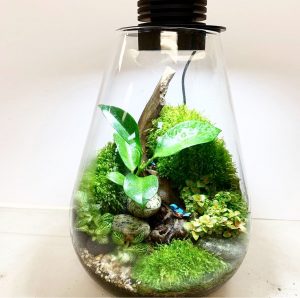

CARING FOR YOUR TERRARIUM
Placement of your Terrarium:
Your Terrarium will thrive and be happy in a well-lit room away from direct sunlight. Occasional rotation will help with even plant growth.
Keeping your plants healthy:
Remove any weeds and/or sick plants or wilting parts of plants such as old leaves or flowers to avoid decay and decomposition.
Trim any leaves touching the sides of the Terrarium to avoid rotting and decay.
Do not fertilise your Terrarium.
Watering
Your closed terrarium is like a mini ecosystem. When created properly they do not require much watering. When to water your Terrarium can be determined by the appearance of condensation on the inside of the glass. Condensation on the inside of the glass occurs due to the humid environment created by the substrate layers and allows the Terrarium to water itself.
Over watering will cause the plants to rot and die. If you are unsure if your closed terrarium has enough water observe the condensation levels on the inside walls.
If there is light condensation on the inside of the glass your Terrarium does not require watering. If the walls are completely fogged and dripping you will need to leave the lid off for a day and let some fresh air in and to allow some of the water to evaporate. If you can see water within the drainage gravel at the base there is too much water and you will need to leave the lid off to allow some water to evaporate.
Be careful that the plants do not become too dry because they will wilt.
When you do add water, do so in small amounts at a time, since there is no place for the surplus water to drain. It’s best to water with a misting spray bottle. Spray the Terrarium only a few times and then replace the lid and observe the condensation levels on the glass for another day. It is easier to manage a Terrarium by adding a little bit of moisture than to over water.
Mould
Mould is a frequent phenomenon and a reality in terrariums due to warm moist conditions. Thankfully it’s more of a nuisance than a problem. Sadly mould is one of those things that’s hard to eliminate completely because it reproduces via microscopic spores. Mould can enter your terrarium via soil, plants and mosses, hardscape branches, rocks and the air.
Treatment of mould –
- Mould thrives on moisture. Opening your closed terrarium for brief periods to allow air flow will help to reduce the humidity levels.
- Hydrogen Peroxide 3% – Dip a Q Tip into 3% Hydrogen Peroxide and dab directly onto affected areas
- Hydrogen Peroxide 3% – we use a weakened solution of 7.5ml 3% Hydrogen Peroxide & 250ml water in a spray bottle and spray directly onto affected areas.
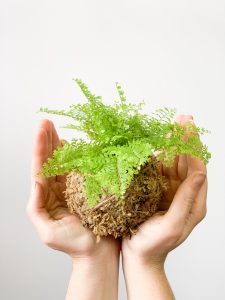
CARING FOR YOUR KOKEDAMA
The weight of your kokedama is a good indicator of whether your plant requires water. If you lift your ball in your hand and it feels light, watering is needed.
Watering
Immerse the ball in a sink or bucket filled with water. Place your ball in the water plant side up and submerge. This can be done by holding the ball under the surface of the water until all of air bubbles escape or by leaving it to soak for up to 30 minutes. If your ball is very dry it will float on the surface. Ideally your kokedama should absorb enough water to saturate the moss and sink. Depending on how dry your ball is this can take anywhere from 10-30 minutes. Once your kokedama is saturated remove the ball and then drain.
Frequency of watering is dependent on time of year and living conditions eg. air conditioning or heating. In winter aim to water approximately once a week. During summer months or in constant air conditioning this may need to be done more regularly. As noted above you can tell if your kokedama requires more watering by observing the sphagnum moss surrounding your plant. As the moss dries it becomes crispy and the ball becomes lighter indicating that your ball requires a drink. Light misting of your kokedama between watering isn’t essential but can help to keep your plants happy. Please note if you have a cactus or succulent kokedama these need to dry out completely before watering again.
If you are a busy person or travelling for a period of time you can leave your kokedama in a saucer of water to draw up its own moisture. I find that the saucer from under a pot works well in this regard
Feeding
Feeding your kokedama at least once every season will also keep your kokedama happy. This can be done one of 2 ways. The easiest way is to add some liquid fertilizer to the water as per the packet instructions and immerse your ball. The second method is to poke some holes through your sphagnum moss and put some osmocote beads inside the ball.
Rebinding your Kokedama
Over time all-natural fibres will break down with water and light. As the twine breaks down you will need to rewrap your ball. This is best done when your kokedama is wet. You can also add a layer of fresh moist sphagnum moss on top of your ball at this time if required.
Kokedama can be kept in indirect filtered light indoors or in your garden. Please avoid direct sunlight.
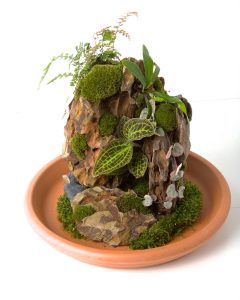
CARING FOR YOUR JEWEL IN THE CROWN
Placement
Place your Piece of Living Art in an area that receives bright natural indirect light. Ensure that no direct sun hits the Glass Dome.
if placing on a piece of furniture it may be an idea to place a spacer under the saucer so as not to mark your furniture from the moisture. This can be done using a felt furniture pads or a round plastic clamp used for garden irrigation.
Watering
Simply fill the saucer with water to allow it to draw water in when required. Keep an eye on the humidity in the inside of the glass and water in the dome. When there is no humidity and no water being pushed out from the Dome refill the saucer as necessary.
Frequency of watering is dependant on time of year and living conditions eg. air conditioning or heating.
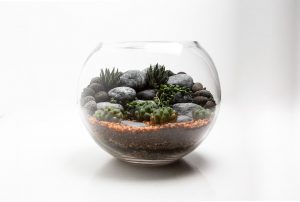
CARING FOR YOUR XEROSPHERE – “DRY CLIMATE TERRARIUM”
Placement of your Terrarium – Your Terrarium will thrive and be happy in a well lit room away from direct sunlight.
Keeping your plants healthy – Remove any weeds or sick plants carefully immediately. Also, remove wilting parts of the plant, such as old leaves or flowers.
Watering – Your Glass Garden does not require much watering. If you have placed String of Pearls in the Garden this will require observation to ensure that it doesn’t dehydrate. All of the plants can be given small amounts of water using a spray bottle approximately every 2 – 4 weeks. The amount of water you give your plants will depend on it’s living conditions. If you have air conditioning and/or heating on in your home it may require extra water. During Winter your plants will also require less water.
Over watering will cause the plants to rot and die. Excess water will naturally reside in the bottom of the Glass Bowl and if extreme will struggle to evaporate.
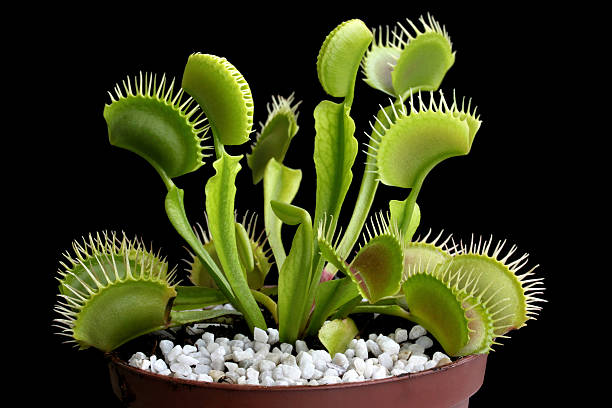
CARING FOR YOUR VENUS FLY TRAP – Dionaea Muscipula
Venus Fly Traps are best grown outside receiving at least 4 – 5 hours of direct sun. If growing inside they must revive direct sunlight for as long as possible. If the plant does not receive enough light the traps will become smaller. If this happens find a sunnier position for your plant.
Venus Fly Traps should always be kept moist. The easiest way is to keep them in a saucer of water. It is best if the water level covers 1/5 of the pot’s height.
To ensure longevity of your plant don’t close the traps with fingers!!!! Closing the traps continuously with fingers causes the plant to use excess energy with no reward of food. Each leaf can only shut on average three times; however, the plant is producing new leaves to replace the old ones. Remove any dead leaves as required. If you wish, you can feed your plant once a month with a live fly or insect.
If your plant sends up a flower pinch it off with your fingers as it takes a lot of energy out of the plant. If you wish to repot your plant you should use 5 parts peat moss and 1 part course washed river sand or use straight Sphagnum Moss. Repotting should be done in either Spring or Summer.
During the cooler months the Venus Fly Trap becomes Dormant. Do not throw it away thinking out has died. At this time of year the plants need less water. The trick is to have the soil demo but not soaking wet. When you place your finger on the mix it should feel damp rather than wet and in Spring when the weather warms up it will send up new ;eaves and you can return to filling the saucer with water.
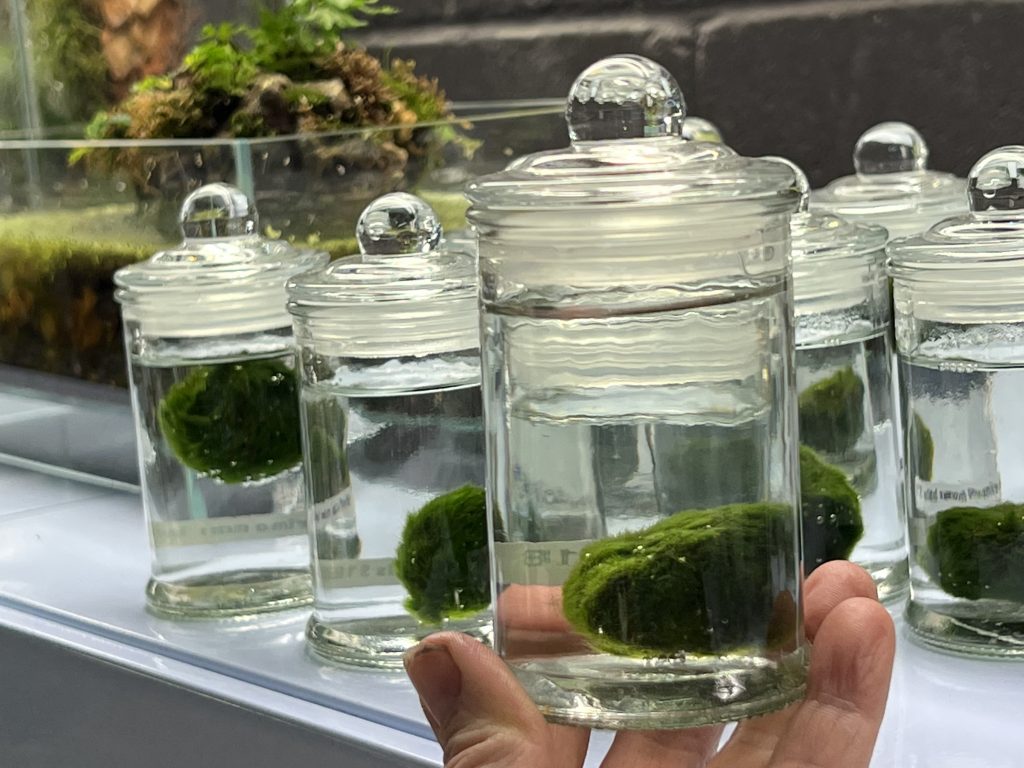
Marimo Moss Ball Care
The botanical name for marimo moss balls is Aegagropila linnaei.
Marimo, is a Japanese word which that translates to “seaweed ball”
Light
Marimo naturally grow at the bottom of the lakes so prefer to best kept in low to medium indirect light. Placing your marimo in direct sun or too much light can cause it to turn brown.
Changing the Water
Change water once every two weeks using regular tap water (for best results, allow water to sit out for 24 hours prior to changing the water to allow chlorine to evaporate). Clean your marimo enclosure with a brush if algae begins to grow on the container surface.
Why are my Marimo Balls Floating?
More than likely, your Marimo balls have an air bubble trapped inside that is causing them to float! Gently squeeze your marimo balls to pop the air bubble. Generally, Marimo will sink to the bottom of their tank within 1-2 days of being added to an enclosure.
Keeping Marimo Shape Round
In their natural habitats, the waves and currents of the lakes gently rotate and roll the Marimo balls along the floor of the lake.
To ensure that Marimo stay keep their round form and don’t flatten out gently agitate the water in your Marimo enclosure, with the goal that when your Marimo balls settle back to the bottom, they rest on a different side than they had prior. Try to simulate the gentle waves of a lake
Browning
If your marimo turn brown, make sure they’re moved to a cooler location with less direct light. They may recover and turn green again on their own. If not, you may add a tiny amount of aquarium ocean salt.